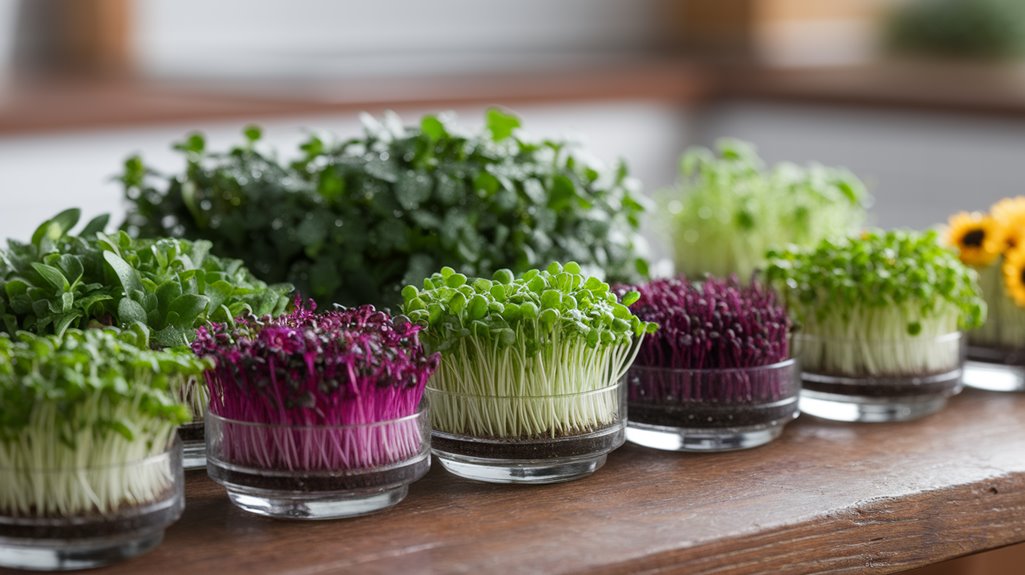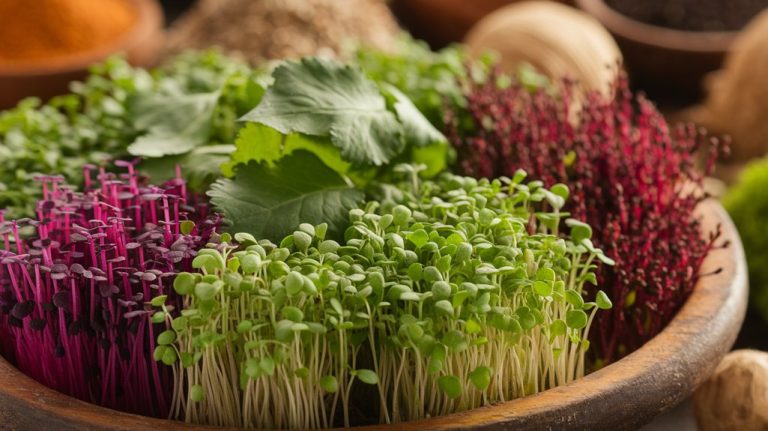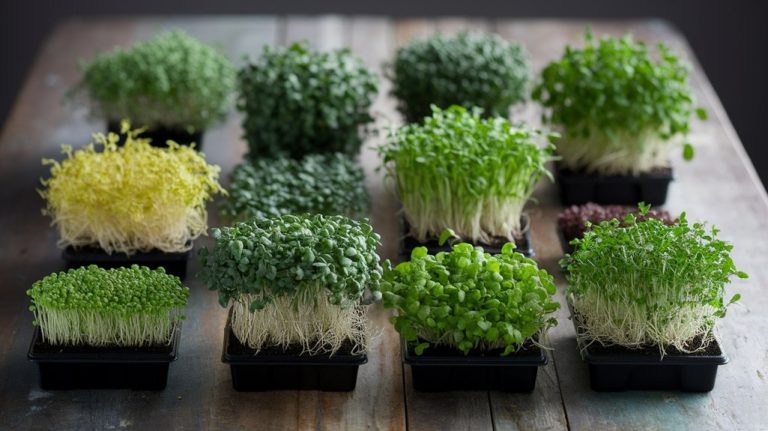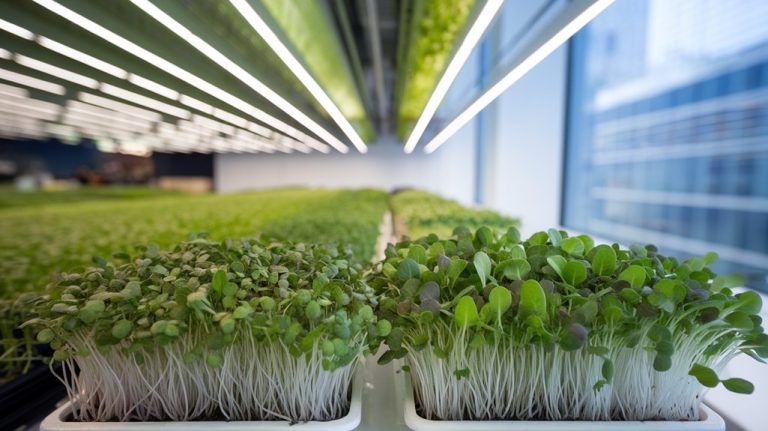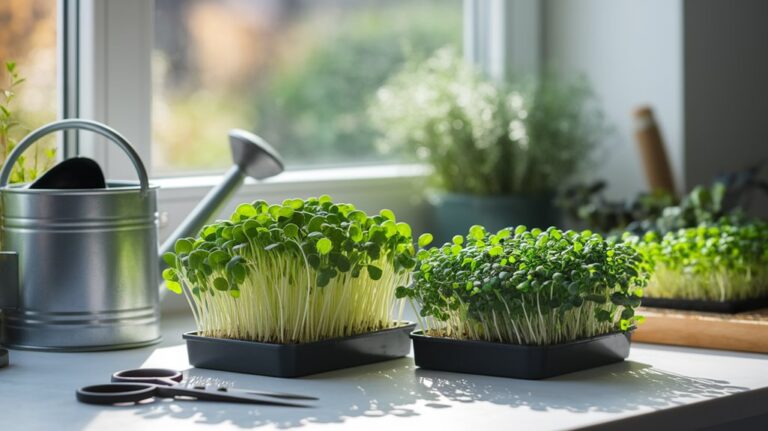How Different Types of Microgreens Affect Your Health
Microgreens are nutrient-dense plants that can significantly improve your health. For instance, arugula offers vitamins A, C, and K, which support bone and immune health. Basil contains anti-inflammatory properties while sunflower microgreens provide a protein boost. Radish microgreens are high in antioxidants, promoting skin health. Incorporating these into my meals not only adds flavor but also enhances my overall nutrition. If you’re curious about specific microgreens and their benefits, there’s much more to explore.
Key Takeaways
- Microgreens like broccoli and kale can have nutrient concentrations up to 40 times higher than their mature counterparts, enhancing overall nutrient intake.
- Arugula and radish microgreens are rich in vitamins A, C, K, and antioxidants, supporting immune health and reducing oxidative stress.
- Basil microgreens contain anti-inflammatory compounds that help alleviate chronic pain and promote relaxation, contributing to overall well-being.
- Beet greens and cabbage microgreens are high in vitamins and minerals, promoting strong bones, heart health, and effective immune responses.
- Sunflower microgreens provide about 25% protein by dry weight, making them an excellent plant-based protein source for a balanced diet.
The Nutritional Powerhouse of Microgreens
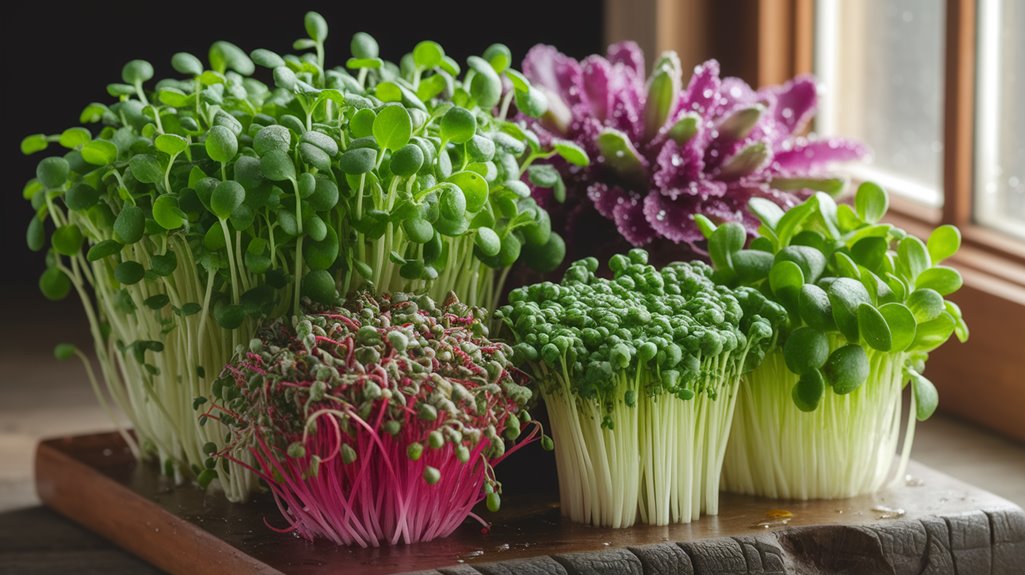
When I first discovered microgreens, I was amazed by their impressive nutritional profile. These tiny greens pack a powerful punch, often containing higher concentrations of vitamins and minerals than their mature counterparts.
For instance, studies show that microgreens like broccoli and kale can have up to 40 times more nutrients than the full-grown plants. They’re rich in antioxidants, which help combat oxidative stress in the body.
By incorporating microgreens into my meals, I’ve noticed an enhancement in both flavor and nutritional value. Whether it’s adding them to salads, smoothies, or sandwiches, the versatility of microgreens makes them an easy addition to a health-conscious diet.
Honestly, they’re a simple way to boost my overall nutrient intake.
Understanding the Health Benefits of Arugula
When I look at arugula, I see more than just a peppery addition to my salads; it’s a nutrient-dense powerhouse.
Research shows that this microgreen is rich in essential vitamins and minerals, making it a valuable part of a balanced diet.
Additionally, its impressive antioxidant properties can play a crucial role in reducing oxidative stress in our bodies.
Nutrient Density Analysis
Arugula stands out in the world of microgreens for its impressive nutrient density, making it a valuable addition to any diet.
When I look at its profile, I can’t help but appreciate the benefits it offers. Here are four key nutrients that highlight arugula’s value:
- Vitamin K – Supports bone health and proper blood clotting.
- Vitamin C – Boosts the immune system and promotes skin health.
- Folate – Essential for cell division and helps prevent neural tube defects during pregnancy.
- Calcium – Vital for strong bones and teeth.
Including arugula in my meals not only adds flavor but also enhances my overall nutrient intake.
It’s a simple way to make health-conscious choices.
Antioxidant Properties Explained
While exploring the health benefits of various microgreens, I’ve come to appreciate arugula for its remarkable antioxidant properties.
Packed with vitamins A, C, and K, arugula offers an impressive array of antioxidants, including glucosinolates and flavonoids. These compounds play a crucial role in neutralizing free radicals in our bodies, which can help reduce oxidative stress and lower the risk of chronic diseases.
Research indicates that consuming arugula may enhance heart health, support immune function, and even contribute to cancer prevention.
By incorporating arugula into my diet, I’m not just adding flavor; I’m also boosting my overall health.
Basil: a Sweet Addition With Medicinal Properties
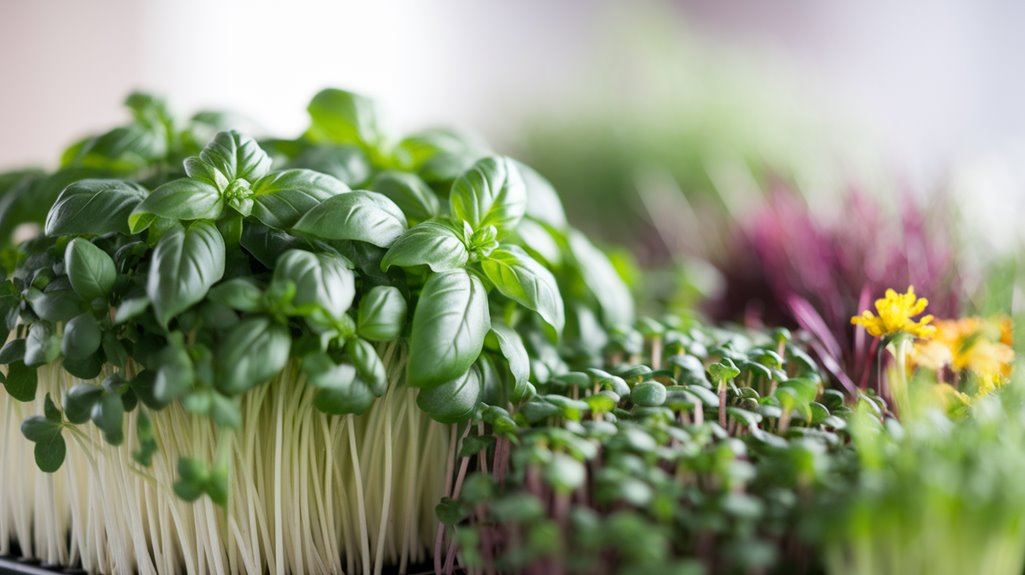
Basil isn’t just a flavorful herb; it also boasts numerous health benefits that make it a valuable addition to any diet.
I’ve found that incorporating basil microgreens into my meals has enhanced both taste and nutrition.
Here are four key health benefits:
- Anti-inflammatory properties: Basil contains compounds that help reduce inflammation in the body, potentially alleviating chronic pain.
- Stress relief: The essential oils in basil can promote relaxation and lower stress levels, supporting mental well-being.
- Antimicrobial effects: Basil has natural antimicrobial properties, which can help fend off harmful bacteria.
- Rich in vitamins: It’s packed with vitamins A, C, and K, which are essential for immune function and overall health.
Adding basil microgreens to my dishes has truly enriched my meals and my health.
The Antioxidant Boost From Radish Microgreens
When I compare the nutrient density of radish microgreens to other vegetables, I’m often surprised by their impressive antioxidant levels.
These tiny greens pack a powerful punch, offering health benefits that can contribute to overall well-being.
Let’s explore how incorporating radish microgreens into our diets can enhance our health through these antioxidants.
Nutrient Density Comparison
Radish microgreens pack an impressive nutritional punch, especially when it comes to their antioxidant content. I’ve found that comparing their nutrient density to other microgreens reveals just how beneficial they really are.
Here are four key points to consider:
- High Antioxidant Levels: Radish microgreens contain significantly more antioxidants than mature radishes, helping to combat oxidative stress.
- Vitamins and Minerals: They’re rich in vitamins A, C, and E, which play vital roles in immune function and skin health.
- Low Caloric Density: With minimal calories, they’re an excellent way to add nutrients without weight gain.
- Fiber Content: Their fiber helps with digestion, promoting gut health alongside their antioxidant benefits.
Incorporating radish microgreens into my diet has truly elevated my nutrient intake.
Health Benefits Overview
Although I’ve always been aware of the importance of antioxidants in our diet, the significant boost I get from radish microgreens has truly impressed me.
These tiny greens pack a powerful punch with high levels of vitamins C and E, both known for their antioxidant properties. Research shows that the antioxidants found in radish microgreens can help neutralize free radicals, reducing oxidative stress in our bodies.
This not only supports overall health but may also lower the risk of chronic diseases, such as heart disease and cancer. Incorporating radish microgreens into my meals has become a simple yet effective way to enhance my nutrient intake and bolster my immune system.
They’re a delicious addition to salads and sandwiches, too!
Broccoli Microgreens: Cancer-Fighting Potential
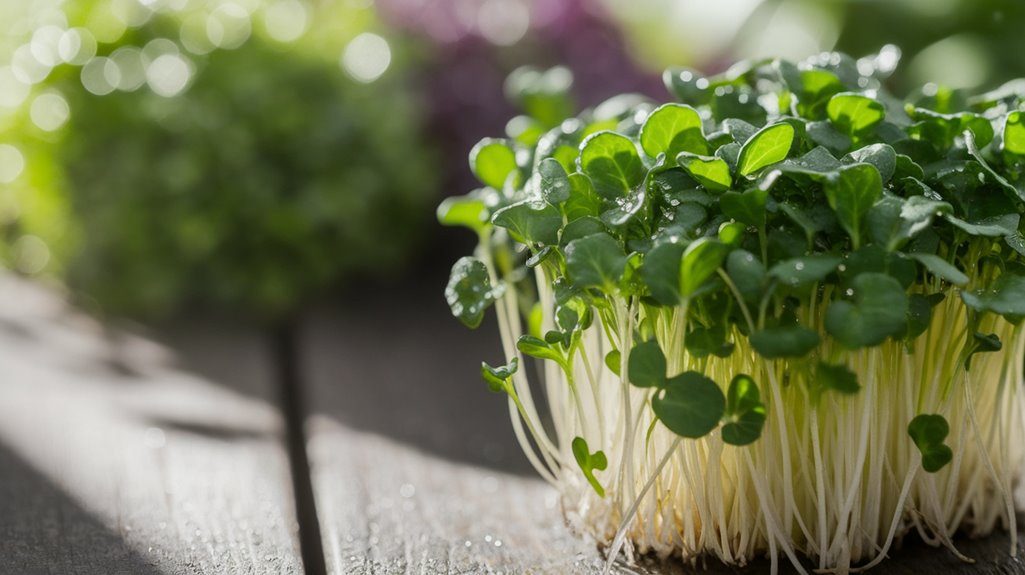
Broccoli microgreens, packed with nutrients and bioactive compounds, have garnered attention for their potential cancer-fighting properties.
I’ve found that incorporating them into my diet may offer several benefits:
- High Sulforaphane Content: This compound has been linked to cancer prevention by inhibiting tumor growth.
- Rich in Antioxidants: Broccoli microgreens contain antioxidants that combat oxidative stress, a factor in cancer development.
- Anti-Inflammatory Properties: They may reduce inflammation, which is often associated with cancer progression.
- Nutrient Density: They’re a concentrated source of vitamins and minerals, supporting overall health and potentially enhancing the body’s ability to fight cancer.
In my experience, adding these microgreens to salads or smoothies is an easy way to boost my health.
The Digestive Benefits of Pea Shoots
Pea shoots offer a delightful way to enhance digestive health, as they’re rich in dietary fiber, which plays a crucial role in maintaining a healthy gut. This fiber not only promotes regular bowel movements but also supports the growth of beneficial gut bacteria.
When I include pea shoots in my meals, I notice they help prevent bloating and provide a feeling of fullness, which can aid in weight management. Additionally, the vitamins and minerals found in pea shoots, such as vitamin C and folate, contribute to overall digestive wellness.
Incorporating these vibrant greens into salads, smoothies, or sandwiches can be an easy, tasty way to support your digestive health daily. Trust me; your gut will thank you!
Enhancing Flavor and Health With Beet Greens
Beet greens aren’t just a delicious addition to your meals; they pack a nutritional punch with vitamins A, C, and K.
I love experimenting with their unique flavor in various dishes, and they pair well with ingredients like citrus and nuts.
Plus, growing your own microgreens at home can make it easy to incorporate these health benefits into your diet.
Nutritional Benefits of Beet Greens
When exploring the world of microgreens, beet greens stand out not only for their vibrant color but also for their impressive nutritional profile.
These greens pack a powerful punch, making them a must-add to your diet. Here are four key benefits:
- Rich in Antioxidants: Beet greens contain betalains, which help reduce oxidative stress in the body.
- High in Vitamins: They’re an excellent source of vitamins A, C, and K, supporting immune health and skin integrity.
- Mineral Powerhouse: These greens are rich in calcium, magnesium, and potassium, promoting strong bones and heart health.
- Dietary Fiber: Their fiber content aids digestion and helps maintain healthy blood sugar levels.
Incorporating beet greens into your meals can significantly enhance your overall health.
Culinary Uses and Pairings
Adding beet greens to your meals not only boosts their nutritional value but also enhances their flavor profile. These vibrant greens have a slightly sweet, earthy taste that pairs well with various dishes.
I love tossing them into salads for a nutrient-rich crunch or sautéing them with garlic and olive oil for a delightful side dish.
You can also incorporate beet greens into smoothies, providing a nutrient-dense base while masking their robust flavor with fruits like bananas or berries.
They complement grains like quinoa or farro beautifully, adding texture and color.
Growing Your Own Microgreens
Growing your own microgreens can be a rewarding endeavor, especially when it comes to enhancing the flavor and health benefits of your meals with beet greens.
I’ve found that growing these vibrant greens isn’t only simple but also incredibly nutritious. Here are a few reasons to start:
- Nutrient-Rich: Beet greens are packed with vitamins A, C, and K, along with essential minerals like iron and calcium.
- Flavor Booster: Their earthy, slightly sweet taste complements a variety of dishes, from salads to sandwiches.
- Quick Growth: Microgreens typically grow in just 7-14 days, making them a fast addition to your gardening routine.
- Cost-Effective: Growing your own can save you money compared to store-bought options.
Start your microgreens journey today!
Sunflower Microgreens: A Protein Source
Sunflower microgreens stand out as a remarkable source of plant-based protein, making them an excellent addition to any diet. These tiny greens pack a powerful nutritional punch, containing about 25% protein by dry weight. This makes them an ideal option for those looking to increase their protein intake without relying on animal products.
They’re not just about protein; they’re also rich in essential amino acids, vitamins, and minerals that support overall health. I often toss them into salads, sandwiches, or smoothies for an added nutrient boost.
Incorporating sunflower microgreens into my meals not only enhances flavor and texture but also contributes to my daily protein needs, making them a versatile and nutritious choice for anyone seeking a healthier lifestyle.
The Immune-Boosting Qualities of Cabbage Microgreens
While many people seek out various foods to strengthen their immune systems, cabbage microgreens often get overlooked despite their impressive health benefits.
I’ve discovered that these tiny greens are packed with essential nutrients that can significantly bolster immunity. Here are four key ways cabbage microgreens can enhance your health:
- High in Antioxidants: They contain powerful antioxidants like vitamins C and E, which combat free radicals.
- Rich in Vitamins: Loaded with vitamins A, C, and K, they support various immune functions.
- Anti-inflammatory Properties: They help reduce inflammation, a key factor in immune response.
- Digestive Health: Their fiber content promotes gut health, crucial for a strong immune system.
Incorporating these microgreens can be a simple yet effective way to support your overall health.
Incorporating Microgreens Into Your Daily Diet
How can I easily add microgreens to my daily meals? Incorporating microgreens into my diet has been a game-changer for nutrition.
I sprinkle them on salads for an extra crunch and burst of flavor. Adding a handful of radish microgreens to my sandwiches or wraps not only enhances taste but also boosts vitamins and minerals.
I love blending them into smoothies for a nutrient kick without altering the flavor significantly. Even in scrambled eggs, a sprinkle of spinach microgreens adds color and health benefits.
Research shows that these tiny greens pack up to 40 times the nutrients of their mature counterparts. By integrating them into various dishes, I ensure I’m maximizing my health benefits effortlessly.
Frequently Asked Questions
Conclusion
Incorporating microgreens into my daily diet has been a game-changer for my health. Each variety offers unique benefits, from arugula’s nutrient density to the cancer-fighting properties of broccoli microgreens. I’ve found that adding these tiny powerhouses not only enhances my meals but also boosts my overall well-being. By making microgreens a regular part of my nutrition, I feel more vibrant and energized. I encourage you to explore these flavorful greens and experience their benefits for yourself!

